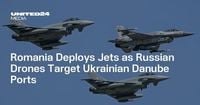In the early hours of August 20, 2025, the skies above Eastern Europe were alive with tension and uncertainty. As Russian forces unleashed a barrage of nearly 150 drones on Ukrainian territory, killing four people in a single day, neighboring countries braced for the possibility that the violence could spill across their borders. According to official statements from Ukraine and corroborated by multiple outlets, the drone and missile blitz was one of the most intense in recent months, targeting critical infrastructure and civilian areas alike.
Romania, which shares a lengthy border with Ukraine along the Danube River, responded swiftly. The country’s Ministry of National Defense announced that it had scrambled two German Air Force Typhoon jets to patrol the airspace over northern Tulcea County, a region that sits precariously close to the Ukrainian ports now under regular attack. The jets, part of a NATO deployment, were dispatched after Romania’s sophisticated air surveillance systems detected groups of drones fired by Russia toward Ukrainian targets on the Danube.
"During the mission, no intrusion of any aircraft into national airspace was detected. The jets returned to base and landed safely at 01:10," the Romanian defense ministry stated, as reported by United24 Media. The operation was a clear demonstration of Romania’s commitment to preventing the conflict from crossing into its own territory, but it also underscored just how close the war has come to NATO’s doorstep.
Romania’s quick response on August 20 was not an isolated event. Earlier in the month, on the night of August 5 to 6, the Ministry of Defense had deployed two F-16 fighter jets after Russian forces launched a large-scale drone attack on Ukraine’s Odesa region. Those strikes, which targeted civilian infrastructure in the Izmail area near the Romanian border, prompted radar systems to pick up aerial targets dangerously close to Tulcea County. Local residents were jolted awake by the RO-Alert system at 01:10, warning them of potential danger overhead.
For months, Russian missile and drone attacks have battered Ukraine, with the intensity only growing as the conflict drags on. According to reports from Hindustan Times, Russia’s use of Shahed drones—supplied by Iran—has been particularly devastating. In some cities, these drones have sparked massive blazes and left as many as five people dead in a single strike. Ukrainian troops have faced not just aerial bombardment but also deadly ambushes by Russian snipers, with one recent attack resulting in approximately 50 Ukrainian casualties and the destruction of US-supplied Abrams tanks.
The timing of these latest drone attacks was especially fraught. They occurred just minutes after a tense meeting between former US President Donald Trump and Ukrainian President Volodymyr Zelensky in the Oval Office. While the details of the discussions remain closely guarded, the proximity of the attacks to such high-level diplomatic engagement raised uncomfortable questions about Russia’s intentions and its willingness to escalate the conflict even as international leaders sought solutions.
Meanwhile, the threat of spillover became all too real for Poland, another NATO member bordering Ukraine. Just days before the August 20 incident, an unidentified drone crashed and exploded in a cornfield in eastern Poland, setting off alarm bells in Warsaw and Brussels. Poland’s Armed Forces quickly issued a statement saying that no airspace violations had been detected, but according to Rzeczpospolita, unnamed sources confirmed that the wreckage bore a striking resemblance to the Shahed-131 or Shahed-136 suicide drones that Russia has used extensively in its campaign against Ukraine.
These events have heightened concerns throughout the region about the possibility of the war crossing into NATO territory. Romania’s Ministry of Defense has been explicit: the deployment of allied aircraft is part of a broader set of security measures designed to prevent exactly that kind of spillover. The Danube region, with its proximity to Ukrainian ports and frequent attacks, remains a particular flashpoint. As Moscow steps up its campaign against Ukrainian infrastructure, the risk to neighboring countries grows ever more acute.
For ordinary people living along the borders, the psychological toll is mounting. Residents of Tulcea County have grown accustomed to the sound of fighter jets overhead and the sudden blare of emergency alerts in the dead of night. In Poland, the sight of drone wreckage in a peaceful cornfield is a stark reminder that no one is truly insulated from the violence raging just across the frontier.
European leaders have not been shy in their criticism of Russia’s tactics. As reported by the Hindustan Times, EU officials have jabbed at both Moscow and former President Trump for their roles in the ongoing crisis. Zelensky, for his part, has found himself increasingly isolated, with some European leaders questioning the effectiveness of Western support and the prospects for a negotiated peace. The relentless nature of the attacks—and the apparent willingness of the Kremlin to ignore international boundaries—has left many feeling that the conflict is entering a new and even more dangerous phase.
Yet, for all the fear and uncertainty, there is also a sense of grim determination. The rapid deployment of NATO aircraft, the vigilance of air defense systems, and the readiness of local authorities to warn their citizens all speak to a region that is refusing to be cowed by the threat of escalation. As one Romanian official put it in the official statement, the measures are "aimed at preventing spillover risks from Russia’s continued strikes on Ukraine."
Still, the events of August 19 and 20—a day that saw both deadly attacks in Ukraine and a near-miss in NATO airspace—are a sobering reminder of just how precarious the situation has become. With Russian drones and missiles flying perilously close to EU and NATO borders, the risk of a broader conflict looms larger than ever. The world is watching, and for those living in the shadow of war, every night brings new uncertainty—and the hope that, come morning, the violence will not have crossed the line.




